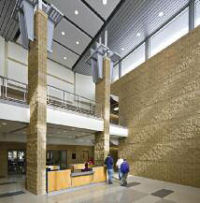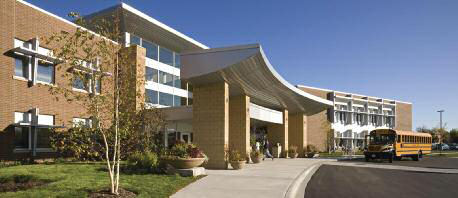Planning for Special Needs
 |
The 108,000-square-foot, three-story building serves 250 students in middle school through age 21.
A Collaborative Approach
District 287 was created by 13 Minneapolis west metro-area school districts to provide educational services and programs that complement and support their programs.
From its inception, the center presented a challenging array of planning and design goals. It was designed so that each program would occupy its own unique space while still presenting an integrated environment.
In addition, the building was designed with the flexibility to accommodate cost-effective reconfigurations as programs and priorities change.
District 287 and TSP, an architectural firm with several offices in the Midwest, began planning with several school stakeholders in 2005. Planners collaborated with several agencies and groups, including the City of Richfield, Richfield Public Schools, neighborhood residents, Nine Mile Creek Watershed District and Xcel Energy, each of which contributed to the design direction and influenced the outcome.
Asking the Right Questions
TSP led the district’s team through a series of planning exercises that began with broad philosophical issues and then progressively narrowed the focus to pragmatic details. This dynamic process evolved as the mindset changed from “making do” with existing facilities to envisioning a collaborative learning environment ideal for each learner.
Planners and designers posed questions that were intended to elicit information about unique students’ needs as well as shared needs. The right questions and thoughtful listening led the design team to the most appropriate solutions.
For example, the Students with Unique Needs program serves students from 5 to 21 years old who have intense social, emotional and behavioral needs, along with cognitive and other health impairments, such as autism, fetal alcohol spectrum disorders and anxiety disorders.
Through the planning and design exercise, TSP learned that these students benefit from a customized curriculum in an environment in which class sizes are very small, with three to four students per classroom. Designers learned that the environment must be designed to minimize noise and distractions to help the students feel calm.
 |
|
The South Education Center was designed to serve special needs students from 13 Minneapolis-area school districts.
|
Spaces are carpeted and have acoustical wall treatments to minimize noise and the impact of disruptions. The common area includes a large motor-skills room with swings, rocking chairs, balls, access to a shared multi-purpose room for recreation and calming, and a separate dining space for students who are unable to dine with others.
The staff shares a common workroom, which allows space to collaborate, communicate and share resources. The workroom is adjacent to classrooms so teachers are close at hand and available for students and to assist other staff.
|
Sustainable design concepts were integrated from the inception of planning.
The district participated in Xcel Energy’s Energy Design Assistance program, which allowed TSP to work with the Weidt Group to model various possible design options and ultimately choose the most cost effective solutions.
The mechanical system uses displacement ventilation and a geothermal heat pump system to deliver fresh air to the occupant zone through low-velocity, high-volume diffusers.
The geothermal well field located under the parking lot and heat pumps within the building deliver heating and cooling to the individual spaces.
Heat pumps are configured to provide optimal energy transfer of heating and cooling from the ground to the rooms to reduce total energy demand. The system is estimated to provide an annual energy saving of over $160,000, with a payback period of less than five years.
The daylighting system consists of exterior sun-shading devices, special glazing to diffuse sunlight, sloped ceilings to bounce sunlight farther into interior spaces and lighting controls to reduce reliance on artificial lights. A rain garden was created for stormwater management. Other green concepts include recycled materials, materials with low-VOC content, reflective roof surfacing, and a site that is near transit lines.
|
